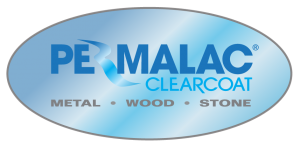Some of our most frequently asked questions.
Permalac will not yellow from sunlight.
Yes, Permalac can be applied over painted surfaces as long as the paint is acrylic, solvent-based or latex-based for the most part. Permalac cannot go over enamels or oil-based paints due to chemical incompatibility.
There are a few things that can cause you to see white spots when spraying Permalac. 1) If you are spraying Permalac using an aerosol can, sometimes the matting agent in the formula will not disperse well enough if not shaken properly. Shake the can for a good 1-2 minutes prior to applying the Permalac to fix this issue. If this doesn’t fix it, be sure to check the batch number on the bottom of the can to make sure it hasn’t expired. Also be sure to inspect the can for signs of damage which could also cause this issue. 2) If you are spraying Permalac using a spray gun, make sure to check that you have stirred the Permalac well and that the solution hasn’t dried up due to having been unused for some time. If this is the case, add some lacquer thinner, acetone, or xylene solvent to reconstitute your formula and dissolve the excess flattening powder back into the solution.
Hazing (a milky white appearance), spider webbing (strings spraying out of the spray gun), solvent pop (craters in the cured finish), and blushing (cloudiness trapped within the cured finish) are more commonly observed when spraying Permalac in a very hot or humid environment. You can combat this by first adding around 20-50% of a standard lacquer thinner, such as our #281 or #69, to your Permalac. If this doesn’t fix the issue, add an additional 5% of a retarding thinner, such as our #500, to the mix. This will slow down the cure rate of the solution and cause the Permalac to stay “wet”a bit longer. It can take up to an hour to cure, but this should resolve the issue(s) you are seeing. If this still doesn’t fix the problem for you, contact us for further troubleshooting assistance.
Permalac provides exceptional protection against sunlight, moisture, and salt.
Permalac is compatible with acrylic paints and solvent-based paints. This means you can apply Permalac over most types of acrylics and solvent-based coatings without any issues. Permalac is NOT compatible over top of enamels or oil-based paints (many of them at least). Please proceed with caution and test a small area prior to applying the product regardless just to be careful.
Permalac is a very versatile coating. It can be applied to metal, masonry, and wood. It can also be applied over paints (acrylic, latex, and solvent) and patinas. Substrates need to be clean and dry before applying Permalac.
Permalac should be applied at temperatures above 50°F. In hot conditions, a slow thinner such as #69 should be used as well as a retarding thinner such as the #500 (will help slow the cure rate to keep a uniform finish).
Permalac takes between 24-72 hours to fully cure. We recommend waiting the full 72 hours before any substrates coated with Permalac are installed or transported.
Permalac typically lasts up to 10 years on indoor structures and approximate 3-5 years on outdoor structures with a single application (3 coats minimum indoors and 4 coats minimum outdoors). Our formula has not changed, though the design of our cans has. Permalac spray cans have a shelf life of 2-3 years from the date of manufacture, after which they should be safely discarded. Quarts, gallons and larger sizes have a shelf life of 2 years from the date of manufacture. You should have the same lacquer, but all of our products now come with a specific designation as to which finish it is.
A second coat can be applied as soon as the first coat is touch dry, usually in 15 minutes.
A single gallon of Permalac will cover 400 square feet.
Permalac works best when a minimum of 3 coats is applied for indoor applications or 4 coats for outdoor applications. It is best to stick to these numbers when possible to assure good product performance.
For outdoor applications, the Permalac lifespan averages out to 3-5 years. For indoor applications, Permalac lifespan is about 8-10 years. It is recommended to perform normal maintenance and reapplication every 3-5 years to keep your substrate protected!
Allow a minimum of 72 hours prior to installing or exposing the Permalac-coated surface to wear and tear. This will ensure your substrate is fully cured and ready to take on the elements.
Surfaces should be free of grease, dust, and moisture. Make sure to keep the surface of your substrate degreased and dry by wiping it down with lacquer thinner or acetone (only when applicable). You may also wish to clean the surface with a mild soap and water solution prior to wiping it down with solvent.
Permalac can be sprayed, brushed on, or dipped. It is available in convenient spray cans for smaller jobs. Cans are available in many different sizes. See our store for all of the options!
Fresh Permalac can be applied over old Permalac, even years later.
Permalac is water clear and will not alter the color of a substrate. Applied over polished metal it is very nearly invisible, over metal patina it will cause a slight darkening.
Permalac can be applied over a powder coated surface; however, you cannot powder coat over Permalac as it will burn/melt off at the excessively high temperature required for powder coating. Permalac satin or semi-gloss sheens are suggested for use over powder coated surfaces to maintain a higher gloss level, identical to the powder coating.

